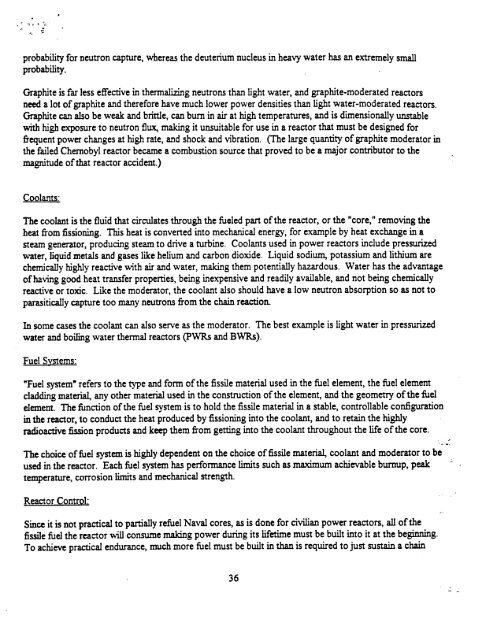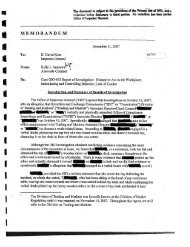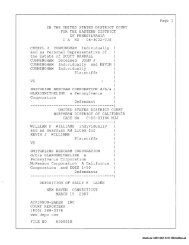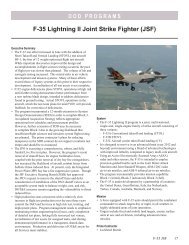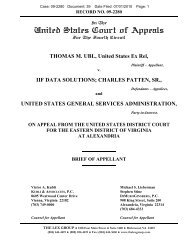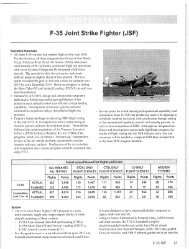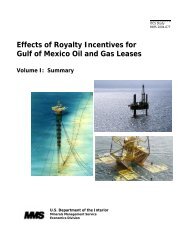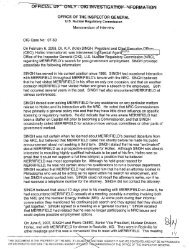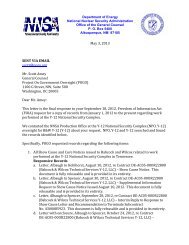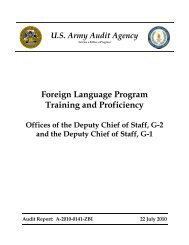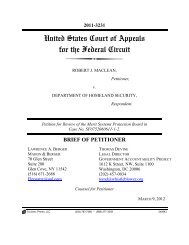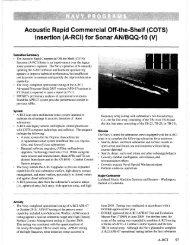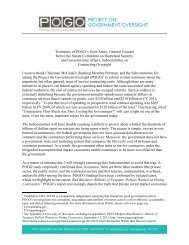REPORT ON IN NAVAL NUCLEAR JUNE, 1995
REPORT ON IN NAVAL NUCLEAR JUNE, 1995
REPORT ON IN NAVAL NUCLEAR JUNE, 1995
Create successful ePaper yourself
Turn your PDF publications into a flip-book with our unique Google optimized e-Paper software.
." -" ..",,)<br />
~ .<br />
.~ -~<br />
.<br />
probability for neutron capture, whereas the deuterium nucleus in heavy water has an extremely small<br />
probability.<br />
Graphite is far less effective in thermalizing neutrons than light water, and graphite-moderated reactors<br />
need a lot of graphite and therefore have much lower power densities than light water-moderated reactors.<br />
Graphite can also be weak and brittle, can bum in air at high temperatures, and is dimensionally unstable<br />
with high exposure to neutron flux, making it unsuitable for use in a reactor that must be designed for<br />
frequent power changes at high rate, and shock and 'vibration. (The large quantity of graphite moderator in<br />
the failed Chemobyl reactor became a combustion source that proved to be a major contributor to the<br />
magnitude of that reactor accident.)<br />
Coolants:<br />
The coolant is the fluid that circulates through the fueled part of the reactor, or the "core," removing the<br />
heat from fissioning. This heat is converted into mechanical energy, for example by heat exchange in a<br />
stearn generator, producing steam to drive a turbine. Coolants used in power reactors include pressurized<br />
water, liquid metals and gases like helium and carbon dioxide. Liquid sodium, potassium and lithium are<br />
chemically highly reactive with air and water, making them potentially hazardous. Water has the advantage<br />
of having good heat transfer properties, being inexpensive and readily available, and not being chemically<br />
reactive or toxic. Like the moderator, the coolant also should have a low neutron absorption so as not to<br />
parasitically capture too many neutrons from the chain reaction.<br />
In some cases the coolant can also serve as the moderator. The best example is light water in pressurized<br />
water and boiling water thermal reactors (pWRs and BWRs).<br />
Fuel S~stems:<br />
"Fuel system" refers to the type and form of the fissile material used in the fuel element, the fuel element<br />
cladding material, any other material used in the construction of the element, and the geometry of the fuel<br />
element. The function of the fuel system is to hold the fissile material in a stable, controllable configuration<br />
in the reactor, to conduct the heat produced by fissioning into the coolant, and to retain the highly<br />
radioactive fission products and keep them from getting into the coolant throughout the life of the core.<br />
The choice of fuel system is highly dependent on the choice of fissile material, coolant and moderator to be<br />
used in the reactor. Each fuel system has perfom1ante limits such as maximum achievable bumup, peak ;.<br />
temperamre, corrosion limits and mechanical strength.<br />
Reactor Control:<br />
Since it is not practical to partially refuel Naval cores, as is done for ci\ilian power reactors, all of the<br />
fissile fuel the reactor will consume making power during its lifetime must be built into it at the beginning.<br />
To achieve practical endurance, much more fuel must be built in than is required to just sustain a chain<br />
36<br />
-<br />
--


